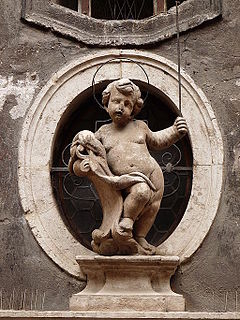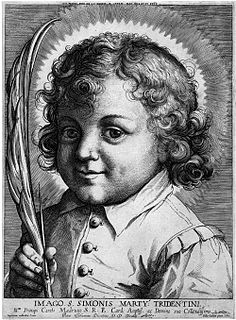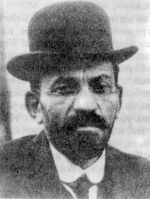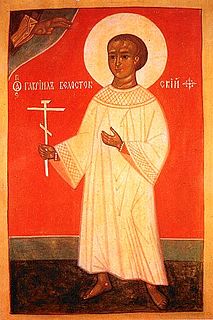Antisemitism has increased greatly in the Arab world since the beginning of the 20th century, for several reasons: the dissolution and breakdown of the Ottoman Empire and traditional Islamic society; European influence, brought about by Western imperialism and Arab Christians; Nazi propaganda and relations between Nazi Germany and the Arab world; resentment over Jewish nationalism; the rise of Arab nationalism; and the widespread proliferation of anti-Jewish and anti-Zionist conspiracy theories.

Blood libel or ritual murder libel is an antisemitic canard which falsely accuses Jews of murdering Christian boys in order to use their blood in the performance of religious rituals. Historically, echoing very old myths of secret cultic practices in many prehistoric societies, the claim as it is leveled against Jews, was rarely attested to in antiquity. It was however, frequently attached to early communities of Christians in the Roman Empire, re-emerging as a European Christian accusation against Jews in the medieval period. This libel—alongside those of well poisoning and host desecration—became a major theme of the persecution of Jews in Europe from that period to the present day.
Antisemitism in Christianity, a form of religious antisemitism, is the feeling of hostility which some Christian Churches, Christian groups, and ordinary Christians have towards the Jewish religion and the Jewish people.

Simon of Trent, also known as Simeon (1472–1475), was a boy from the city of Trent, in the Prince-Bishopric of Trent, whose disappearance and death was blamed on the leaders of the city's Jewish community, based on the confessions of Jews obtained under judicial torture.
Massena is a village in St. Lawrence County, New York, United States. The village is named after André Masséna, one of Napoleon's generals.

The Damascus affair of 1840 refers to the arrest of several notable members of the Jewish community in Damascus on the accusation of murdering Father Thomas, a Christian monk, and his Muslim servant for the purpose of using their blood to bake matzo, an anti-semitic accusation also known as the blood libel.

Menahem Mendel Beilis was a Russian Jew accused of ritual murder in Kiev in the Russian Empire in a notorious 1913 trial, known as the "Beilis trial" or the "Beilis affair". Although Beilis was eventually acquitted after a lengthy process, the legal process sparked international criticism of antisemitism in the Russian Empire.
Antisemitism in the history of the Jews in the Middle Ages became increasingly prevalent in the Late Middle Ages. Early instances of pogroms against Jews are recorded in the context of the First Crusade. Expulsion of Jews from cities and instances of blood libel become increasingly common in the 13th to 15th centuries. This trend peaked only after the end of the medieval period, and subsided only with Jewish emancipation in the late 18th to 19th century.
Antisemitic canards are "sensational reports, misrepresentations, or fabrications" that are defamatory towards Judaism as a religion or defamatory towards Jews as an ethnic or religious group. Since the Middle Ages, they have formed parts of broader antisemitic conspiracy theories.

Gabriel of Białystok is a child saint in the Russian Orthodox Church. The legend of his death describes a ritual murder which has been described as a blood libel. His feast day is held on April 20.
The Rhodes blood libel was an 1840 event of blood libel against Jews, in which the Greek Orthodox community accused Jews on the island of Rhodes of the ritual murder of a Christian boy who disappeared in February of that year.

There have been different opinions among historians with regard to the extent of antisemitism in America's past and how American antisemitism contrasted with its European counterpart. Earlier students of American Jewish life minimized the presence of antisemitism in the United States, which they considered a late and alien phenomenon that arose on the American scene in the late 19th century. More recently however, scholars have asserted that no period in American Jewish history was free from antisemitism. The debate about the significance of antisemitism during different periods of American history has continued to the present day.
Antisemitism —prejudice, hatred of, or discrimination against Jews— has experienced a long history of expression since the days of ancient civilizations, with most of it having originated in the Christian and pre-Christian civilizations of Europe.
The Topoľčany pogrom was an antisemitic riot in Topoľčany, Slovakia, on 24 September 1945 and the best-known incident of postwar violence against Jews in Slovakia. The underlying cause was resurgent antisemitism directed at Jewish Holocaust survivors who demanded the return of property that had been stolen during the Holocaust. Rumors spread that a local Catholic school would be nationalized and the nuns who taught there replaced by Jewish teachers.
Antisemitism in Turkey refers to acts of hostility against Jews in the Republic of Turkey, as well as the promotion of antisemitic views and beliefs in that country.
Antisemitism in Greece manifests itself in religious, political and media discourse. The 2009-2018 Greek government-debt crisis has facilitated the rise of far right groups in Greece, most notably the formerly obscure Golden Dawn.
The 1934 Constantine riots was an anti-Jewish riot that erupted in the Algerian city of Constantine. The background of the tension between Jews and Muslims in the city was rooted in the different manner in which Jews and Muslims had been treated in the Algerian state by the French colonial government. It is uncertain what the exact cause of the riots was, though various accounts suggest that the riots were triggered by an altercation between a Jewish man and some Muslims at the Sidi Lakhdar Mosque in Constantine. Multiple sources report that 25 Jews and 3 Muslims died over the course of the three-day riot, and several Jewish establishments were pillaged. The events have also been described as a pogrom.

This timeline of antisemitism chronicles the facts of antisemitism, hostile actions or discrimination against Jews as a religious or ethnic group, in the 20th century. It includes events in the history of antisemitic thought, actions taken to combat or relieve the effects of antisemitism, and events that affected the prevalence of antisemitism in later years. The history of antisemitism can be traced from ancient times to the present day.
Saul S. Friedman was an American historian.
Postwar anti-Jewish violence in Slovakia resulted in at least 36 deaths of Jews and more than 100 injuries between 1945 and 1948, according to research by the Polish historian Anna Cichopek. Overall, it was significantly less severe than in Poland. The causes of the violence included antisemitism and conflict over the restitution of property stolen from Jews during the Holocaust in Slovakia.







